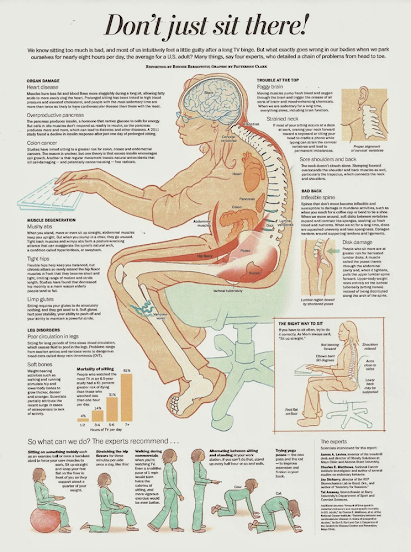
Hi Readers, I was recently forwarded this article by a
colleague and I am sharing it with you. Sitting for too long is harmful to your
health. What is too much? Keep reading. At the end of Tiberian’s article, is my
article on the same topic posted here on my blog on March 23, 2015, almost ten
years ago! At the end of this blog post is a picture of how sitting incorrectly
at a workstation harms the body. There is also a link to download that
infographic. I know I am sitting a little taller typing this post! AgeDoc
Too Much
Sitting May Harm Your Health
By Janet
Tiberian, MA, MPH, CHES Janet
Tiberian is a health educator. She has more than 25 years’ experience in
chronic disease prevention and therapeutic exercise.
Many people spend hours of
their day sitting at a workstation – for work, to manage personal finances or
engage in a hobby like gaming. That sewing desk, painter’s easel and work bench
are also workstations.
But sitting for hours at a
time can take a toll on your health. In fact, about 15 years ago, long-term
sitting became recognized as a public health issue. It was even deemed as “the
new smoking” because studies found long-term sitting raised the risk for
vascular problems, high blood pressure, unhealthy cholesterol levels, heart
disease, type 2 diabetes, dementia, obesity, cancer and back pain.
“Long-term sitting can
interfere with proper metabolic function, slow circulation, promote feelings of
exhaustion and cause postural complications and musculoskeletal issues,” says
Bernard Kaminetsky, MD.
If you’re sitting between 8
and 11 hours a day, you’re at high risk for these conditions, while sitting
between 4 and 8 hours provides a moderate risk and less than 4 hours is
considered low risk. Fortunately, you can help alleviate the negative effects of
sitting with these tips.
Use Ergonomic Principles
Ergonomics is the
study of people’s efficiency in their working environment. Understanding its
principles can help prevent aches, pains and fatigue, as well as help you work
more proficiently. Ergonomic measurements vary among people, but you can try
these steps from University of California at Los Angeles (UCLA): https://ergonomics.ucla.edu/office-ergonomics/4-steps-set-your-workstation
Stand Up Periodically
Whether you’re sitting for
periods of time to work, write in a journal, knit or even drive, it’s important
to incorporate moments of standing in your day. Standing helps lower blood
sugar, stress, fatigue and risk factors for heart disease. That said, if your
work involves sitting, make sure you stand up at least every 30 minutes. When
standing, use proper posture, which means you should:
- Stand
up straight. - Align
your ears over your shoulders. - Gently
glide your chin back straight. - Align
your shoulders over your hips. - Pull
in your stomach. - Place
your weight predominantly on the balls of your feet. - Keep
your feet about shoulder-width apart.
Many activities can be performed while standing. This is
why some people opt for standing desks. If you’re interested in using a
standing desk, but your company doesn’t provide them or you don’t feel like
purchasing one for your home, use a high table or counter and position your
workstation according to your height. Click this link for recommendations on
setting up your sitting to standing workstation: https://www.uclahealth.org/safety/ergonomics/office-ergonomics/sitting-standing-workstations
Keep in mind that prolonged
standing also has health drawbacks, such as muscle soreness, fatigue, slower
reaction time and it may increase the risk for circulatory issues like deep
vein thrombosis and varicose veins. This is why you may want a sit-to-stand
desk, a type of workstation with both sitting and standing options.
Walk Around for Few Minutes
Whether you’re sitting for
hours at a workstation or on a couch to knit, watch television or doomscroll on
social media, you should get up and walk around for five minutes, every half
hour. Walking 5 minutes for every 30 minutes of prolonged sitting helps offset
many of the harmful effects associated with sitting, according to a
study published in Medicine & Science in Sports & Exercise.
My original article posted here on 3/23/15, almost ten
years ago! The material is still relevlent, although I am wearing an Apple Watch now instead of a Jawbone UP that reminds me to get up and walk. Ah, the information age! AgeDoc
Sitting Too Much Each Day May Result in
Disability or Early Death
Hi Readers,
Everyone knows that
sitting too much and being a couch potato is generally not good for health,
right? Well, the term, “couch potato” brings to mind an overweight,
lazy person on the sofa eating fatty snacks and watching television. However,
scientists conducted a study and found that people who sit most of the day have
an increased risk of developing heart disease, diabetes, cancer, and shortened
lifespans. Published in the peer-reviewed scholarly journal, Annals
of Internal Medicine, researcher Aviroop Biswas and his research team
reviewed 47 health studies [a meta-analysis] and found that people who sit most
of the day are 24% more likely to die from these conditions compared to their
counterparts who are more active during the day even when they exercise
an hour or more daily! An hour of exercise daily does not mitigate all of
that sitting.
So what is “sitting too
much?” Biswas defined it as sitting from 8-12 hours
daily. That places a person at great risk and his team recommended
that sitting should be limited to 4-5 hours maximum per day. People
who sit at a computer/desk all day and professional drivers may be at the
greatest risk because their occupation requires sitting. The researchers found
that sitting compresses vital organs and impacts metabolism
negatively. It may result in leg disorders from poor circulation,
muscle degeneration, organ damage, spinal damage, soft bones, diabetes, and
cancer. What is a virtual professor to do?
The experts suggest
reducing time spent sitting by watching television standing up, taking walks or
walk around, and gradually reduce sedentary sitting time each
day. Currently, I wear a Jawbone UP that reminds me to get up and
move every hour. I may have to invest in one of those standing
desks! See attached diagram of sitting hazards with suggestions for how to
sit when you must sit. AgeDoc
References:
The below infographic shows how the brain, back,
organs, muscles, and limbs can all be affected simply by lack of
movement. Download
the infographic, print it out and hang it by your desk as a reminder to get
up and move!
Berkowitz, B., & Clark, P. (2014, January
20). The health hazards of sitting. Don’t just sit there!
Poster. Washington Post online.
Biswas, A., Oh, P.I., Faulkner, G.E., Bajaj, R.R.,
Silver, M.A., Mitchell, M.S., Atler, D.A. (2015). Sedentary time and
its association with risk for disease incidence, mortality, and hospitalization
in adults. Annals of Internal Medicine, 162(2),
123-132.
U.S. National Library of Medicine. National Institutes
of Health. (2015, January 19). Too much sitting can be
deadly- even if you exercise, review finds. Retrieved from http://www.nlm.nih.gov/medlineplus/news/fullstory_150482.html




